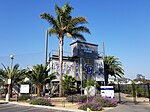Goleta Slough

The Goleta Slough is an area of estuary, tidal creeks, tidal marsh, and wetlands near Goleta, California, United States. It primarily consists of the filled and unfilled remnants of the historic inner Goleta Bay about 8 miles (13 km) west of Santa Barbara. The slough empties into the Pacific Ocean through an intermittently closed mouth at Goleta Beach County Park just east of the UCSB campus and Isla Vista. The slough drains the Goleta Valley and watershed, and receives the water of all of the major creeks in the Goleta area including the southern face of the Santa Ynez Mountains. The Santa Barbara Airport has the largest border on the slough and contains the largest part of the slough. UCSB, Isla Vista, the City of Goleta and other unincorporated areas of the county, including the landward bluffs of More Mesa, surround and encompass the rest of the slough. The Goleta Slough was impacted by two events of the late 19th century and first half of the 20th century. The first was the heavy grazing by cattle on the surrounding foothills and mountainsides followed by wide-ranging grassfires, heavy rains in 1861/62, and flooding which caused so much erosion and deposition of sediment in the mouths of the creeks emptying into Goleta Bay that most of the bay became silt-filled salt marsh in just a couple of years. The second event was the conversion of the marsh and remaining bay into a military airbase during World War II. The fill material was obtained by reducing the rest of Mescalitan Island which provided the material to fill the airport and the surrounding area. The former location of Mescalitan Island now contains a sewage treatment plant. While no longer having a regularly navigable mouth, nor depths in most places suitable for anything except canoes, kayaks, and very small boats, the slough remains a very important area of vital wetlands, salt marsh, and estuarian creeks. "The Goleta Slough wetlands ... are fragmented along the coast from More Mesa to UCSB Storke Campus". The Goleta Slough Ecological Reserve is administered by the Calif. Dept. of Fish and Game. The Slough contains approximately 430 acres (1.7 km2) of wetland habitat (including the 360 acres (1.5 km2) ecological reserve and 14.8 acres (60,000 m2) at Storke Campus). The approximate historic area was 1,150 acres (4.7 km2)."The primary function of the Ecological Reserve is to provide habitat for wildlife and a setting for educational and research activities. Public utility and transportation corridors traverse the wetlands while airport runways, a sewage treatment plant, a power generation station, and light industrial facilities are constructed on filled portions of the marsh."
Excerpt from the Wikipedia article Goleta Slough (License: CC BY-SA 3.0, Authors, Images).Goleta Slough
El Colegio Road,
Geographical coordinates (GPS) Address External links Nearby Places Show on map
Geographical coordinates (GPS)
| Latitude | Longitude |
|---|---|
| N 34.423822222222 ° | E -119.84746111111 ° |
Address
Goleta Slough Ecological Reserve
El Colegio Road
93106
California, United States
Open on Google Maps








